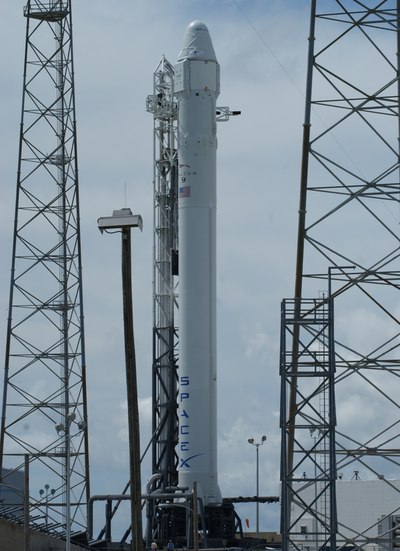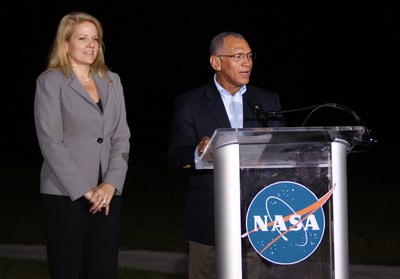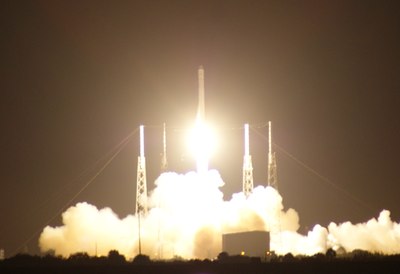Commercial spaceflight gets down to businessby Jeff Foust
|
 The Falcon 9 rocket on the launch pad about seven and half hours before its launch. (credit: J. Foust) |
A not-quite-flawless launch
Sunday’s launch was not the first for either the Dragon spacecraft or the Falcon 9 rocket that boosted it to orbit. However, the three previous Falcon 9 launches—two of which carried Dragon spacecraft and the third a boilerplate Dragon model—were effectively test flights, demonstrating the capability and reliability of the launch vehicle and spacecraft. Beyond some small secondary payloads, as well as a modest amount of cargo on the last Falcon 9/Dragon mission in May (see “A test of technology and a validation of vision”, The Space Review, May 29, 2012), those missions weren’t intended to support the space station or serve other customers.
| This mission is an opportunity to see if commercial spaceflight can, figuratively and literally, deliver the goods. |
This mission, though, is different. Designated CRS-1 as the first mission in NASA’s Commercial Resupply Services program, the Dragon is carrying about 400 kilograms of cargo to the ISS. Nearly half—177 kilograms—comprises what NASA calls “utilization payloads”: experiments and the equipment to support them. That includes experiments in biology, fluid physics, and materials science. The rest of the cargo includes miscellaneous hardware for the station and food, clothing, and other supplies for the crew, including some ice cream tucked away into an experiment freezer in the Dragon at the last minute.
The relatively modest cargo manifest raised questions prior to the launch, since Dragon is billed as having the ability to transport as much as 6,000 kilograms to the station. However, both NASA and SpaceX attributed the low mass to the selection of cargo it’s carrying. “The cargo up that we’re taking is not quite as dense as some of the cargo that we will be taking on successive missions,” said SpaceX president Gwynne Shotwell at a pre-launch press conference on Saturday. She added that SpaceX’s CRS contract with NASA requires it to carry at least 20 metric tons of cargo to the station over 12 flights; she estimates that SpaceX will carry a combined 60 metric tons up to and down from the station on those missions.
Getting that cargo to the ISS, though, required the close cooperation of technology and meteorology. With an instantaneous launch window, there was no margin for error if a technical problem developed during the countdown; each of the previous three Falcon 9 launches had aborts on their initial launch attempts, including one after the main engines ignited on the previous mission in May. (Shotwell did say Saturday that the hot-fire test of this Falcon 9 on the pad the previous weekend took place on schedule, a first.) Weather was also a factor, with clouds and storms forming in the afternoon in recent days before the launch. Forecasts called for a 60% chance of acceptable weather at the 8:35 pm launch time Sunday, improving to 80% if the launch slipped to Monday or Tuesday.
As the hours ticked away towards that initial launch attempt, no technical showstoppers appeared, and by 1 pm Sunday the rocket was standing vertical on the pad. The weather, too, was cooperating, as the previous days’ storms stayed well to the south and west, leaving behind partly cloudy skies and light winds. Both conditions persisted up through launch time and, at 8:35, the skies above Launch Complex 40 lit up as the Falcon’s nine engines ignited and lifted the rocket off the pad.
The Dragon’s ascent to orbit initially appeared to be normal, as the rocket dwindled to an orange-red dot before fading from view entirely for those observing the launch from Cape Canaveral. About ten minutes after liftoff, the Dragon separated from the Falcon’s upper stage and deployed its solar arrays. A press release from SpaceX issued about 15 minutes after liftoff declared that the Falcon 9 “performed nominally today during every phase of its approach to orbit” and included a quote from SpaceX CEO Elon Musk: “We still have a lot of work to do, of course, as we guide Dragon’s approach to the space station. But the launch was an unqualified success.”
At the post-launch press conference at the Kennedy Space Center about 90 minutes after liftoff, Shotwell said the Falcon placed the Dragon spacecraft into a “picture-perfect orbit”, within a couple kilometers on apogee and perigee. However, she said a few minutes later there was an “anomaly” with one of the nine first-stage engines on the rocket, but couldn’t offer any additional information at that time.
Video of the launch did show, about 80 seconds after liftoff, what appeared to be a shower of debris coming from one of the engines. That led to speculation that the engine had exploded, perhaps due to the failure of the engine’s turbopump.
On Monday afternoon, SpaceX issued a follow-up statement offering a few more details about the incident. Contrary to that speculation, the company said, there was no explosion in the engine “because we continued to receive data from it” after it shut down, the company explained. Instead, the company said the engine “lost pressure suddenly,” causing computers to issue a shutdown command. The debris seen in the video, the company said, were panels ejected to protect the other engines. (The failure also demonstrated the “engine-out” capability of the Falcon 9 long touted by SpaceX.)
| “The SpaceX Dragon is a really important vehicle for us because it supports the laboratory use of the ISS,” said Robinson. |
The engine failure did have an effect on a secondary payload on the rocket. Besides the Dragon, the Falcon carried a prototype next-generation “OG2” satellite for ORBCOMM, a company that operates a constellation of low Earth orbit communications satellites. The mission plan called for placing the 165-kilogram satellite into its planned orbit with a second burn of the Falcon’s upper stage, after the Dragon separated. Early Monday, though, satellite observers noticed the OG2 satellite was not in that higher orbit.
Late Monday afternoon, ORBCOMM confirmed the satellite was not in its planned orbit, an issue that the company traced back to the first-stage engine failure. “Due to an anomaly on one of the Falcon 9’s first stage engines, the rocket did not comply with a pre-planned International Space Station (ISS) safety gate to allow it to execute the second burn,” the company reported. ORBCOMM said it was working with the satellite’s manufacturer, Sierra Nevada Corporation, to see if the spacecraft’s thrusters can raise the spacecraft to an operational orbit.
 NASA administrator Charles Bolden and SpaceX president Gwynne Shotwell speak to the media after the launch. (credit: J. Foust) |
Improving ISS utilization
Despite the issues with the failed engine and the ORBCOMM satellite, the Dragon spacecraft itself remains on track to carry out its mission. SpaceX said Monday the spacecraft was carrying out the first series of thruster burns to maneuver towards the ISS. If it remains on schedule, Dragon will be grappled by the ISS’s robotic arm and berthed to the station on Wednesday.
Having Dragon on line to transport cargo is not just a validation of the commercial spaceflight approach advocated by NASA and industry, it’s also essential to the operations and long-term future of the ISS itself. “The SpaceX Dragon is a really important vehicle for us because it supports the laboratory use of the ISS,” said ISS program scientist Julie Robinson at a press conference Saturday.
Dragon is particularly important, she said, because of its ability to transport cargo back to Earth from the ISS, a capability not available with other cargo spacecraft. On this particular mission, in fact, Dragon will return with a heavier load than it launched with: almost 760 kilograms, including nearly 400 kilograms of experiments. “It has a great return capability,” said Robinson. “It essentially replaces that capacity that we lost when the shuttle retired.”
One scientist awaiting research samples to be returned by Dragon is Scott Smith of the Johnson Space Center, who studies ways to mitigate the bone loss astronauts experience in weightlessness. That research makes use of blood and urine samples collected by astronauts on the station and stored in freezers there; about 500 of those samples will be returned on this Dragon. “We have not brought back any samples since the last shuttle flight” over a year ago, he said. “This is the first real return vehicle for this kind of sample.”
Having a regular series of flights to transport experiments and other cargo to and from the station may be essential in the long run to demonstrate the scientific utility of the station, which in turn may be critical to the long-term future of the facility and any plans to continue operating it beyond 2020. Some people have criticized the usefulness, or lack thereof, of the station as a laboratory, arguing it’s done little quality science to date.
Robinson, at the pre-launch press conference, argued that the station was just now finding its groove as a laboratory, with more than 200 active experiments on the station today, about half of which are US-based, in a wide range of fields. “The last year of full utilization, from the time that the shuttle retired until today, has been just extraordinary,” she said. “We’ve had record numbers of crew hours going to research and record numbers of investigators active on ISS.”
| “This was a critical event for NASA and the nation tonight. It was what I call a historical event in the annals of spaceflight,” Bolden said. |
NASA and ISS scientists are also looking ahead to another milestone in ISS research. On Friday, NASA announced that the ISS partners had agreed to fly two people, one Russian and one American, on the station for a full year. The flight, planned to start in early 2015, will allow scientists to study the long-term effects of very long duration spaceflight, particularly weightless, on the human body to a far better degree that past extended spaceflights performed by Russian cosmonauts in the 1980s and 1990s.
“The plan is to do it once,” Robinson said of the one-year flight, and see how the data collected on the effects of such a flight match up with trends from shorter missions. She suggested that if the results match up with their expectations, this might be a one-time experiment. “But if we see some big surprises come out of the observations,” she said, “that’s going to send us on a different trajectory.”
The selection of the NASA astronaut to fly that one-year mission will come in the very near future: perhaps by mid to late October, NASA ISS program manager Mike Suffredini said Saturday. “The list of names is very short” right now, he said.
Another feature of the one-year spaceflight not openly discussed by NASA is that, by keeping some crew on the station for a full year while others rotate on more frequent schedules, it frees up seats on Soyuz flights to and from the station that could be sold to space tourists or other paying customers. One of those seats could be claimed as early as Wednesday, as Space Adventures is planning an announcement in Moscow featuring singer Sarah Brightman, rumored for weeks to be interested in flying to the station.
Should this Dragon flight be successful, as well as upcoming test flights of Orbital’s Antares rocket and Cygnus cargo spacecraft (Suffredini said Saturday he now expected the first, demonstration Cygnus flight to the ISS to take place no sooner than late February or early March), it will go a long way to supporting the research on the station and seeing if it is useful enough to warrant keeping the station in operation past the end of the decade. That, in turn, will help support the companies providing both cargo and, later, crew services, giving them a long-term anchor tenant upon which to build up their businesses.
“This was a critical event for NASA and the nation tonight. It was what I call a historical event in the annals of spaceflight,” NASA administrator Charles Bolden said in comments to the media about an hour after the launch. “Just over a year after the retirement of the Space Shuttle, we have returned space station cargo resupply missions to US soil, and are bringing jobs associated with this right back here to America.”
While Bolden’s declaration of victory may be a little premature—Dragon has yet to berth with the station and transfer that cargo—the launch is evidence at last of a transition in spaceflight operations, with commercial entities playing an increasing role in what was previously solely a government domain. The ability of those companies to carry out those new responsibilities will affect not just the future of the commercial spaceflight but also that of the ISS.
